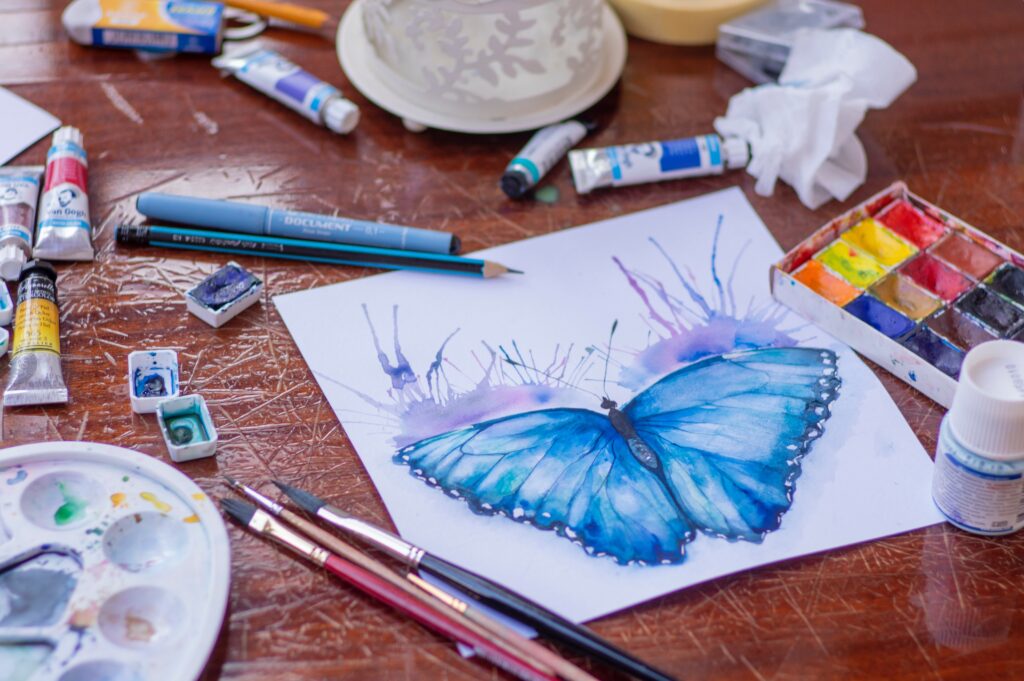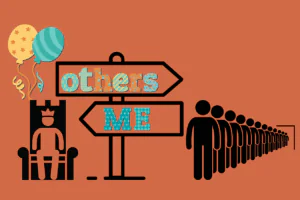guest post by Becky J.
How does art therapy help people who have experienced trauma?
When we are born and begin to develop as human beings, our first expressions are nonverbal. As we age and develop the use of language, we become conditioned to the functions of a society that communicates mostly with words. It is important to note we never lose our ability to communicate in nonverbal ways. It just gets buried under our societal conditioning. Art-making acts as a bridge between what we can say with words, and what exists beyond our capabilities for language.
According to Basil Van der Kolk, Francine Shapiro, and Savneet Talwar, prominent figures in the fields of Trauma research, EMDR, and Art therapy: “In trauma healing, it is not the verbal account of the event that is important, but the non-verbal memory; the fragmented sensory and emotional elements of a traumatic experience. Art therapy is recognized as an effective healing approach that taps into the non-verbal realm of imagery. Successful art therapy, provided by a qualified individual, can integrate right and left brain functions (a process called bilateral stimulation). This helps integrate traumatic experiences, especially on a non-verbal level.” Accessing traumatic memory through art making:An art therapy trauma protocol (ATTP) Savneet Talwar, MA, ATR-BC, LPC ∗The Arts in Psychotherapy 34 (2007) 22–35
The sensory qualities of art-making allow us to access the parts of our brains where traumatic memories are stored. Within the therapeutic relationship, we can build your capacity to resource and work together to help you begin to process and heal from traumatic events. Because of the way trauma is stored in our bodies, sometimes words are not enough to access, process, and heal from traumatic events.
Often with traumatic events, just replaying the events over and over and talking about what happened is not effective. It can actually be retraumatizing for many people. Sometimes traditional talk therapy is not enough. Art therapy can be a very effective and impactful tool on your healing journey because it helps to connect the felt sense of the body and the mind. This allows for release and healing. Art therapy is also a wonderful compliment to other modalities we utilize at Life Care Wellness, such as mindfulness, somatic experiencing, and EMDR.
Does Art Therapy Work?
Therapeutic art-making is ancient, although the field of Art Therapy is relatively new. There is ongoing scientific research about what happens in our brains when we make art. Studies in neurobiology and Qeeg brian mapping, as well as meta-analysis on art therapy and its effectiveness, are showing some exciting results! Art therapy can reduce acute stress symptoms, reduce the stress hormone cortisol, improve the general quality of life, and increase emotional regulation. It also emphasizes the connection between body and mind, which is key to the healing of trauma.
happens in our brains when we make art. Studies in neurobiology and Qeeg brian mapping, as well as meta-analysis on art therapy and its effectiveness, are showing some exciting results! Art therapy can reduce acute stress symptoms, reduce the stress hormone cortisol, improve the general quality of life, and increase emotional regulation. It also emphasizes the connection between body and mind, which is key to the healing of trauma.
Related Reading: Somatic Experiencing for Trauma Healing
Who can benefit from art therapy?
Art therapy is practiced across the world with children, teens, adults, elders, individuals, couples, families, and groups. It is challenging to think of people who would not benefit from art therapy! The world we live in and our human experience is complicated. We have all experienced the shared traumatic event of the recent pandemic. I have worked with clients who are working through pandemic-related grief. Art therapy has helped them develop skills to manage, contain, and process difficult emotions and experiences. The therapeutic art-making process has supported them throughout their grieving process and assisted them in making room in their lives for new experiences and growth. They become able to face new challenges with more confidence in their inherent abilities to cope and flourish in their lives.
Art therapy is highly adaptable and personalized, making it accessible for a variety of needs including people who are nonbinary, neurodivergent, and trauma survivors. Art therapy has also been used to assist in crisis response to natural disasters and to assist communities in healing together after a traumatic event.
It is accessible across cultures, and art therapists undergo training in cultural competence and humility so that we may best serve the communities and individuals we work with.
What type of clinician can deliver these services?
Art therapy is a specialized branch of the field of psychology. It requires a master’s degree and licensure by multiple accreditation boards within the state of Illinois and across the country. If you decide to work with an art therapist, you will be working with someone who has specifically trained to use art to facilitate your psychotherapeutic process. Only art therapists possess this special skill set. We also complete the required training to be licensed as professional counselors. Adhering to the ethical standards of our profession allows us to ensure safe and effective services to our clients. When a clinician works outside their scope of practice in areas where they don’t have appropriate training, there is the risk of doing harm to the people they serve. We are sometimes referred to as a “third hand”. This speaks to our role in the therapeutic relationship rooted in service to our clients.
What if I’m not “good” at art, or have no artistic experience?
Art is a lot more than what is subjectively labeled as good or bad. Art therapy focuses on the healing principles inherent to making art. Learning to use art materials can help you to build self-esteem and agency, and to express yourself in ways that are not available with words alone. There is no judgment of good or bad in art therapy and no grades! It’s more about how art can be used as a therapeutic tool in your healing.
Becky J. is an art therapy and professional counseling intern at Life Care Wellness. She holds a BFA in fine arts and sculpture and is currently pursuing her Master’s degree at Mt. Mary University. Becky utilizes art therapy, mindfulness, and the guiding principles of CBT, DBT, and SE in her work with clients. She works with clients across the lifespan, with varying needs including trauma. She is currently accepting new clients and accepts BCBS and sliding scale.






